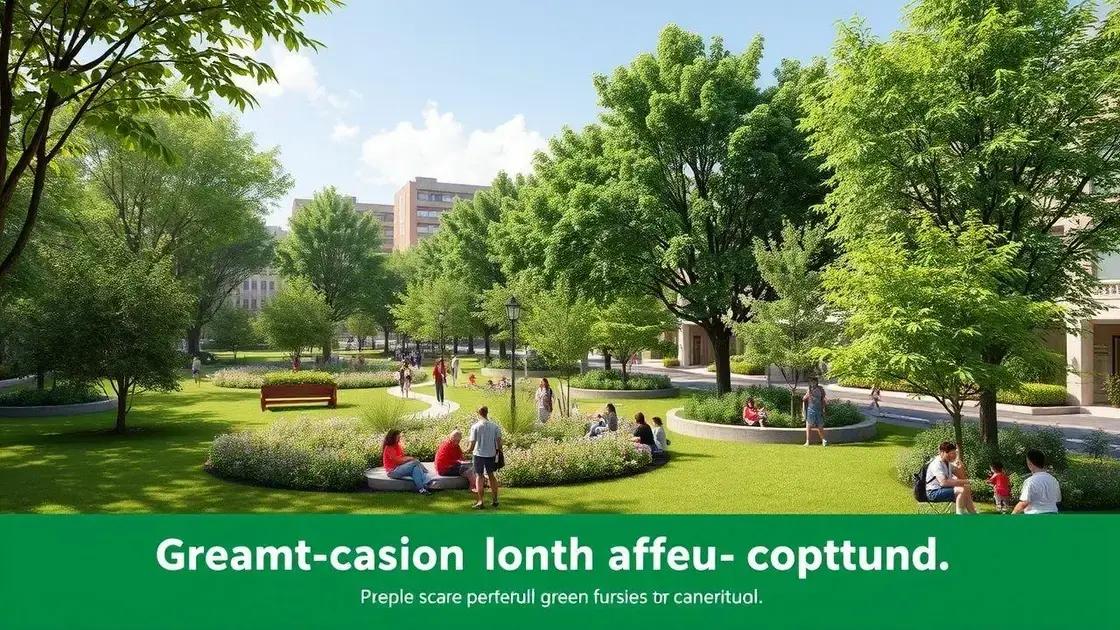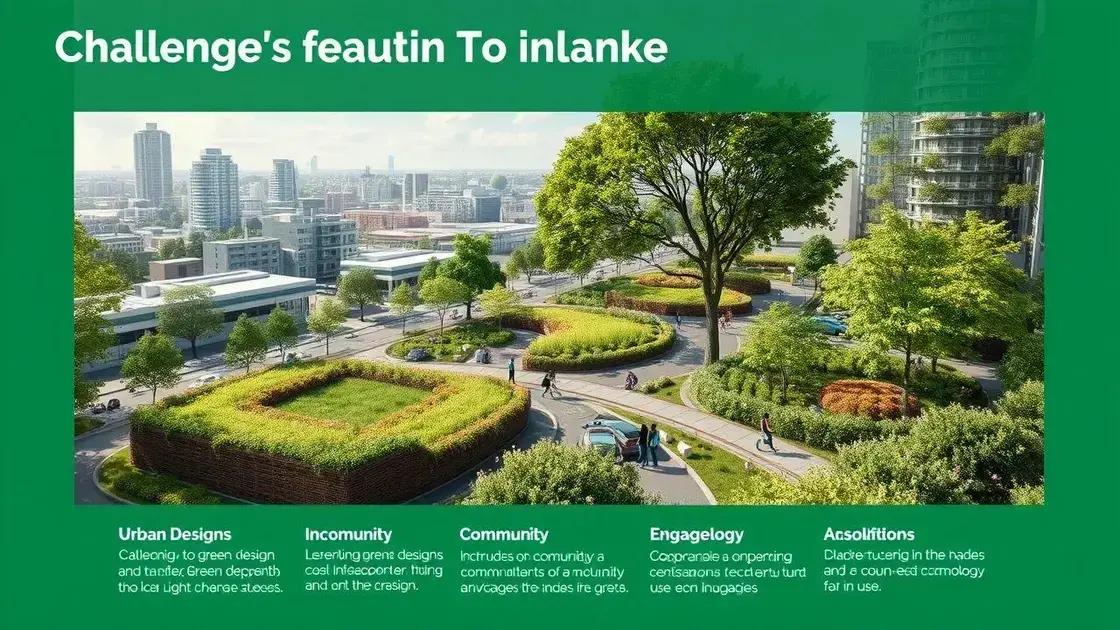Insights on green infrastructure headlines and strategies

Green infrastructure enhances urban sustainability by improving air quality, managing stormwater, supporting biodiversity, and promoting community well-being through the integration of natural elements in city planning.
Insights on green infrastructure headlines can reshape how we think about urban living. Have you ever considered how green spaces influence your quality of life? Let’s dive into the world of sustainable strategies that cities are using to create healthier environments.
Understanding green infrastructure
Understanding green infrastructure is essential for creating sustainable cities. This concept focuses on integrating natural processes into urban environments. It enhances biodiversity while improving residents’ quality of life.
What is Green Infrastructure?
Green infrastructure refers to a network of natural and semi-natural elements aimed at managing stormwater, improving air quality, and providing recreational spaces. These infrastructures can include parks, green roofs, and permeable pavements.
Benefits of Green Infrastructure
Implementing green infrastructure has many advantages:
- Enhanced Biodiversity: Creates habitats for various species.
- Stormwater Management: Reduces flooding risks by absorbing rainfall.
- Improved Air Quality: Plants filter pollutants from the air.
- Social Benefits: Parks and green spaces promote community interaction.
By employing a combination of natural elements and innovative design, cities can tackle environmental challenges. These infrastructures also help mitigate urban heat, making areas more comfortable during hot seasons.
Community involvement plays a crucial role in the success of green infrastructure projects. Engaging residents in the planning process ensures that the spaces reflect community needs and values. Programs that educate people on the benefits of green spaces can increase public support for such initiatives.
Furthermore, green infrastructure positively impacts mental health. Studies show that access to nature can reduce stress and enhance overall well-being. By prioritizing these elements in urban planning, cities can cater to both environmental and human health needs.
Benefits of green infrastructure for urban areas

Understanding the benefits of green infrastructure for urban areas reveals how it contributes to healthier communities and more sustainable living. Integrating nature into city planning offers numerous advantages.
Environmental Benefits
Green infrastructure helps manage rainwater and reduces the urban heat island effect. It encourages biodiversity by providing habitats for wildlife. Moreover, these areas can improve air quality by filtering pollutants.
Social Advantages
Having green spaces enhances community well-being. Residents enjoy physical and mental health improvements when they spend time in nature. This connection fosters social interactions and builds a sense of community.
- Physical Health: Parks promote exercise and outdoor activities.
- Mental Health: Nature helps reduce stress and anxiety.
- Community Engagement: Green spaces bring people together.
Furthermore, green infrastructure can boost local economies. Businesses benefit from increased foot traffic in areas with parks and green spaces. Property values can also rise, as homes near greenery are more desirable to buyers.
Investing in green infrastructure can lead to long-term cost savings for cities. By managing stormwater naturally, urban areas can reduce the burden on conventional sewer systems. This approach can decrease maintenance costs and potential damage during heavy storms.
As cities continue to grow, prioritizing green infrastructure will be crucial. It provides balanced solutions to urban challenges while enhancing the quality of life for residents.
Successful case studies in green infrastructure
Examining successful case studies in green infrastructure can provide valuable insights for cities looking to enhance sustainability. Many urban areas have implemented innovative green solutions that demonstrate the effectiveness of this approach.
New York City’s Green Infrastructure Program
New York City has invested significantly in green infrastructure. Their program focuses on reducing stormwater runoff through various strategies. Green roofs, permeable pavements, and rain gardens have transformed urban landscapes. These solutions not only manage rainfall but also beautify neighborhoods.
Philadelphia’s Green City, Clean Waters
Philadelphia launched the Green City, Clean Waters initiative to address water quality issues. This project aims to manage 85% of the city’s stormwater using green infrastructure by 2035. With green roofs, tree canopy expansions, and bioretention systems, Philadelphia is making strides toward a cleaner environment and enhancing community spaces.
- Community Involvement: Engagement in planning boosts community pride.
- Economic Benefits: Increased property values near green projects.
- Educational Opportunities: Programs to teach residents about sustainability.
Another excellent example can be found in Seattle, Washington. The city has developed numerous urban forests and green spaces that effectively manage stormwater. The partnership between local government and community organizations has led to increased funding for maintenance and expansion of these vital areas.
These case studies illustrate the diverse strategies cities can adopt. By learning from successful implementations, other urban areas can develop tailored green solutions that fit their unique challenges and opportunities. Emphasizing collaboration between governments and communities leads to more resilient urban ecosystems.
Challenges and future trends in green infrastructure

Exploring the challenges and future trends in green infrastructure helps us understand the complexities of implementing these solutions in urban settings. While green infrastructure offers many benefits, several obstacles can hinder its success.
Challenges in Implementation
One major challenge is funding. Many cities struggle to allocate sufficient resources for green infrastructure projects. Without dedicated budgets, these initiatives may stall before they begin. Additionally, the long-term maintenance of green spaces can become costly and complex.
Policy and Regulation Barriers
Regulatory frameworks can also pose challenges. Existing zoning laws and building codes may not support innovative green practices. Cities need to adapt policies that encourage green solutions rather than hinder them, fostering collaboration among different stakeholders.
- Public Awareness: Limited knowledge about the benefits of green infrastructure can slow implementation.
- Climate Change Effects: Extreme weather events create uncertainty in planning.
- Land Use Conflicts: Competing demands for urban space can complicate project locations.
Looking ahead, there are promising trends in green infrastructure. More cities are adopting integrated planning approaches that combine transportation, land use, and environmental goals. This holistic perspective can help create more resilient urban spaces.
Another key trend is the emphasis on community involvement. Engaging residents in the planning process ensures that green infrastructure meets local needs and values. This collaboration can lead to innovative solutions that truly benefit urban dwellers.
Technological advancements also play a significant role in shaping the future of green infrastructure. Smart city technologies can enhance the effectiveness of green solutions by monitoring and managing resources more efficiently. This tech-driven approach opens up new opportunities for sustainable development.
FAQ – Frequently Asked Questions about Green Infrastructure
What is green infrastructure?
Green infrastructure refers to a network of natural and semi-natural elements in urban areas, aimed at managing stormwater, improving air quality, and providing recreational spaces.
What are the benefits of green infrastructure for cities?
Green infrastructure enhances biodiversity, improves air quality, reduces flooding, and promotes community well-being by providing green spaces for recreation.
What challenges do cities face in implementing green infrastructure?
Cities may struggle with funding, regulatory barriers, and public awareness, which can hinder the successful development of green infrastructure projects.
How can communities engage in green infrastructure planning?
Community involvement is crucial. Residents can participate in planning processes, ensuring that green infrastructure meets local needs and reflects community values.






